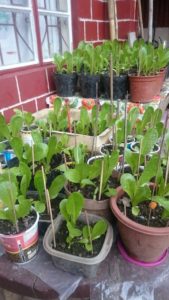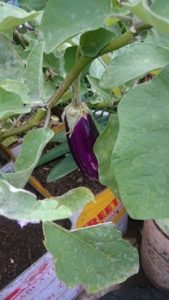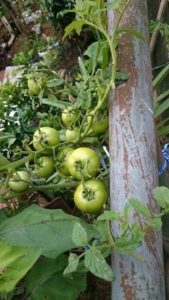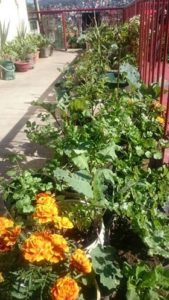Urban Gardening: Growing Herbs and Vegetables
I started urban gardening many years ago by planting several vegetables, herbs and ornamentals using both practical and traditional knowledge and experimenting. Growing up in the province exposed me to gardening—I do not hesitate to hold and mix the soil for pots and other recyclable materials at home. With a limited space of about 100 square meters, my plants were arranged closely—vegetables and fruit-bearing trees such as lemon, orange, guyabano, coffee, guava and papaya were planted for disaster preparedness and to mitigate landslides during typhoons.
The Ayyew-Ubbo Network which I joined in 2016 contributed solutions to the garbage problem of the city. From 2016 to 2018, the Network conducted community visits, meetings and sharing sessions with urban dwellers in the city. In these activities, planting materials were shared from those who had planted enough for others to bring home and replant in reusable containers. Some survived while others did not, possibly due to soil quality, planting season and maturity of the plant cuttings. A permaculturist friend who volunteered at the Magic Garden of Maryknoll Ecological Garden also shared seedlings which I transplanted at home.
In the last quarter of 2017, I was granted a TESDA scholarship course on Training on Agricultural Crop Production NC2 at The Master’s Garden in Puguis, La Trinidad, Benguet. It was overwhelming, and it enriched by knowledge, skills, attitude and values in organic agriculture.
I continued growing crops in containers at home. The planting material was improved with organic matter, and more kinds of vegetables and herbs were introduced to the soil medium. From here, plants started growing robustly especially during the rainy season. A bin was provided for vermiculture for biodegradable waste consisting of fruit peelings, paper, vegetable trimmings, weeds, dried leaves, chopped banana stalks. These were fed to the vermi worms. The vermi compost and vermi tea were used as fertilizer for the plants. Ducks and chicken were also raised to augment the poultry and meat supply of the family. Vegetable trimmings, sayote, rice, overripe fruits were given to the livestock for food. Their waste was used for fertilizer.
The love for growing plants is indeed a passion and a hobby and it instilled in me the love for learning. It is manageable— just spare time to prepare seed beds for seed germination, composting, plant care and harvest. To sustain it, preserve the soil and continue mixing in compost. In the end, we will benefit from it with crops that are readily available, safe and nutritious especially in times of emergency and crisis. Neighbors, relatives, friends, barangay health workers and officials also appreciated the container gardening we are doing and we look forward for them to replicate this in their homes when they ask for seeds, seedlings and cuttings which we were able to share with them. A minimal surplus of vegetables was sold to neighbors and friends since it was primarily used for food consumption of the family.
In passing, I would like to share this piece which I uncovered:
Voice of Nature
We who live in a city have to make an effort to enter into nature. We must prepare for it and spend time on it.
If we are willing to make a little effort, nature will receive us tenderly and be generously preserved to all naturalists.
***
Editor’s Note: The author is an active practitioner of the Ayyew-Ubbo-Vermiculture (AUV) Model and is an active member of the Ayyew Network. Judy’s work in urban gardening have received recognition—first place in the district level container garden category organized by the City Veterinary and Agriculture Office in 2020.




